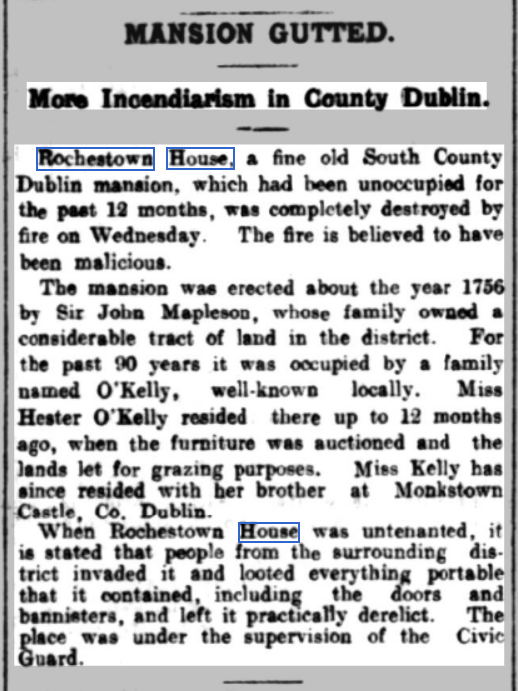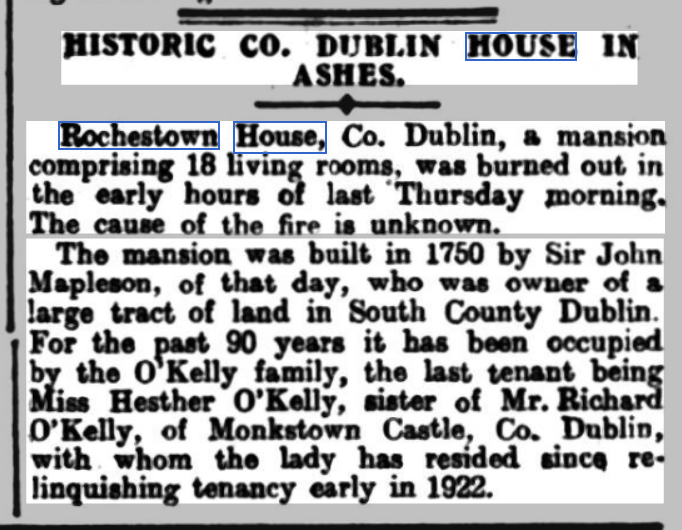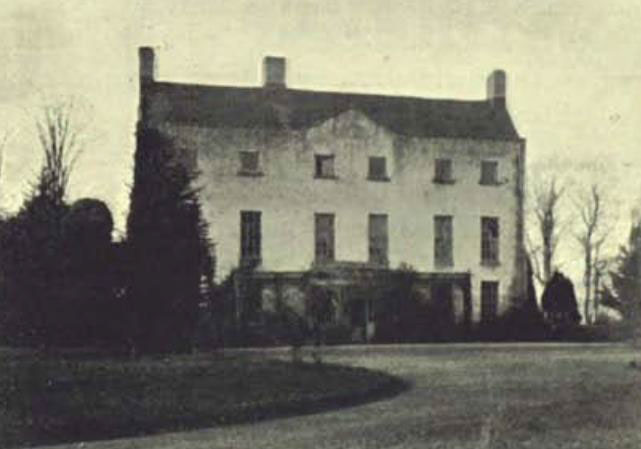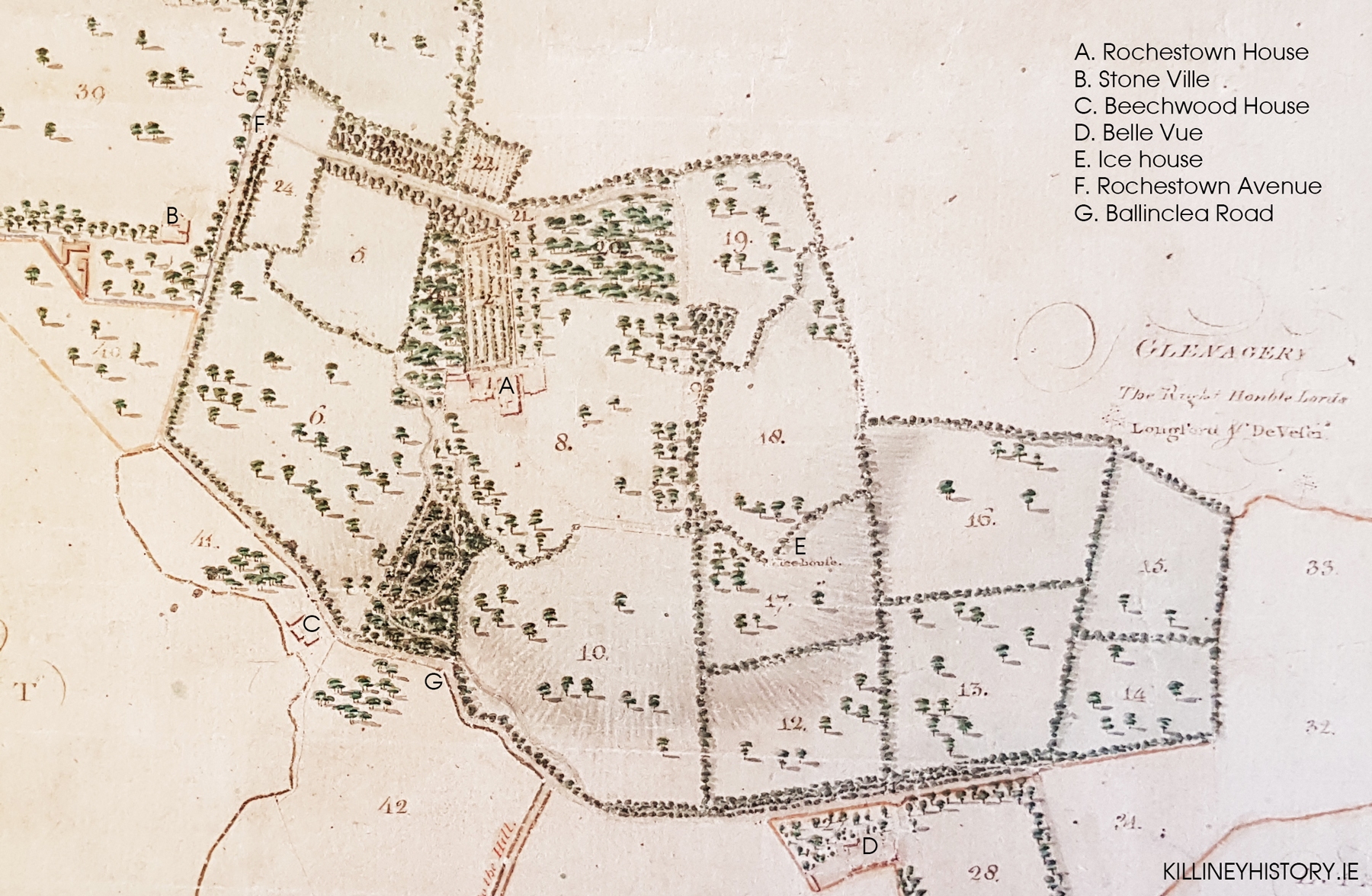Owners and residents over the years
| Year | Name of occupant | Source |
| 1750 | John Mapas (who built, in 1741, the obelisk on Killiney Hill) son of Christopher Mapas | F.E. Ball. History of the County of Dublin (1902) See below |
| 1765 | John Mapas, grandson of John above. | As above |
| 1760 | House was let to Mr. Edward Nicholson, M.P. for Old Leighlin | As above |
| 1796 | Right Hon. William Burton Conyngham | As above |
| 1797 | Mr. Richard Wogan Talbot de Malahide | As above |
| 1802 | Francis Hodgkinson to George W. Mellifont | Talbot Estate papers. Deeds and other documents relating to the Rochestown and Ballinclea Estates, Co. Dublin, 1419-1894. Shelfmark MS Talbot C.93 Bodleian Library, Oxford. p.28 item 23 |
| 1806 | G.W. Mellefont (To be Let) | Dublin Evening Post 10th June 1806 |
| 1815 | George Watters Mellifont to Sir John Talbot K.C.B. | Talbot Estate papers p.26 item 15 |
| 1818/20 | Thomas Lovett | Newspaper notice of ‘A Return of Certificates for Killing Game’ |
| 1831/32 | J. Mongan | Advert for Rochestown School |
| 1837 | J. Morgan (possibly J. Mongan as above) | Lewis’s Topographical Dictionary |
| 1843/68 | Mathias J. O’Kelly | Thoms |
| 1884/1912 | Misses O’Kelly | Thoms |
| 1922 | Hesther O’Kelly | Newspaper report of fire |
| 1923 | Destroyed by fire |
Map of 1787
The Estate Map of John Malpas Esq which was titled ‘A Survey of Rochestown’ lists the tenants of the numerous plots which were leased and provides a brief description of the various properties. The map was prepared by the surveyor Thomas Sherrard in 1787 and is quite accurate in terms of scale and detail. Rochestown Domain, which formed part of the Malpas estate, extended to over 75 acres. The entire estate extended over to Killiney bay and included the townlands of Rochestown Domain, Part of Rochestown, Rochestown Hill, Scalpwilliam (Mount Malpas), Johnstown and Wood Park.
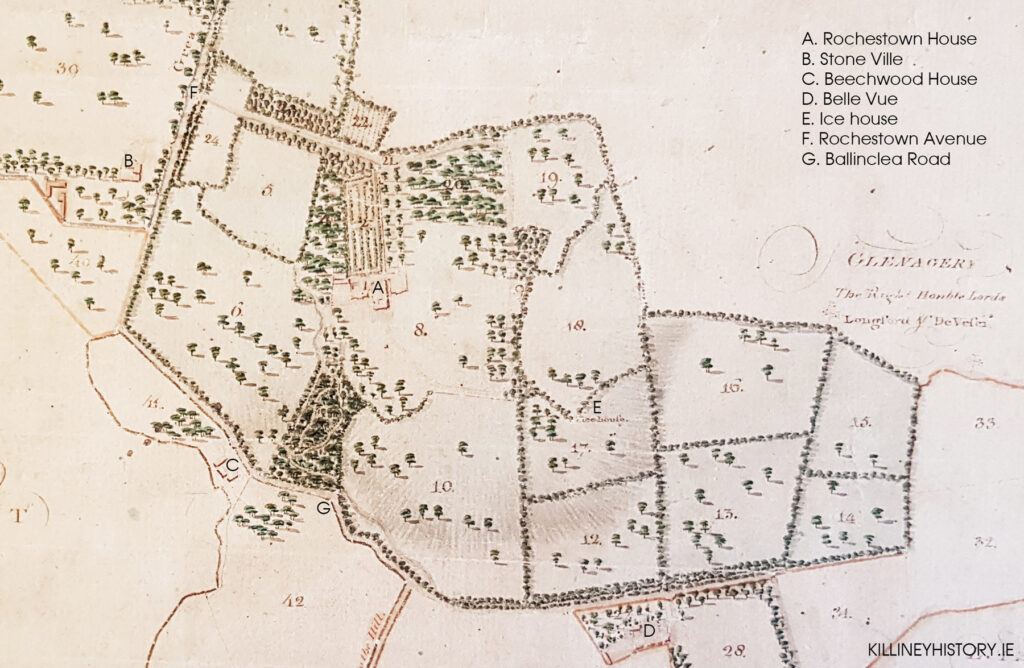
Key to Sherrard map of Rochestown Domain in 1787
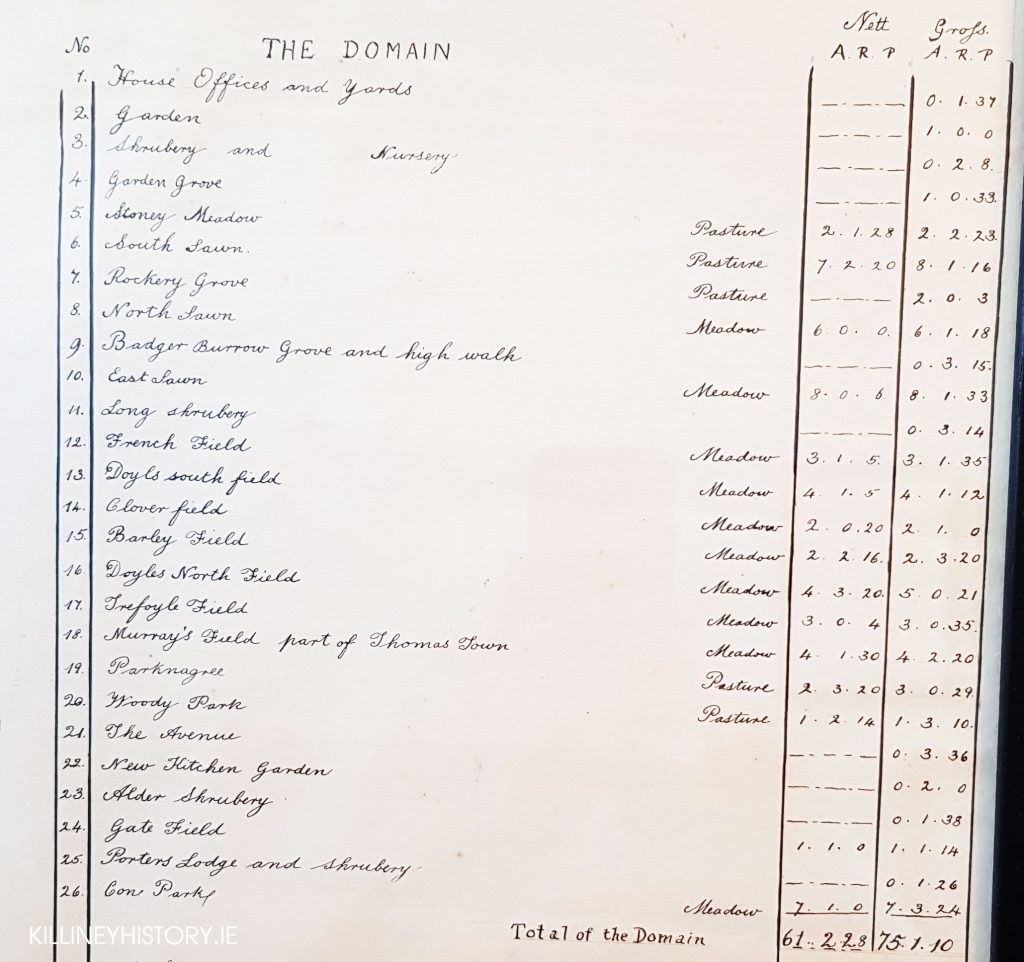
Aerial view of 1958 with overlay of 1787 field and road patterns of the Estate of John Malpas.
This photo was taken in 1958 just as work had begun on building the Bellevue estate at the Glenageary end of the partially constructed Avondale Road . At this stage Rochestown Domain (shaded green) has barely changed since it was laid out in the 18th century.
The numbering legend for the above image refers back to the 1787 handwritten key to the Rochestown Domain. The other fields are identified in the table below.
| Field number/ Area a:r:p | Description | Lessee | Occupant | Townland |
| 27/ 1:0:26 | House Offices Yard and Garden (Bellevue Park House) | T.T. Medly Esq | Mrs. Lill Three lives | Part of Rochestown |
| 28/ 3:2:36 | Lawn and Shrubery, meadow | “ | “ | |
| 29/ 2:0:7 | A Field and Plantation, pasture | “ | “ | |
| 30/ 1:0:24 | A Field, pasture | “ | “ | |
| 31/ 3:0:28 | A Field, pasture | “ | “ | |
| 32/ 4:3:27 | A Field, meadow | “ | “ | |
| 33/ 3:3:17 | A Field, meadow | “ | “ | |
| 39/ 15:3:12 | Renewable | Henry Vaughan Brooke Esq | “ | |
| 40/ 3:2:26 | at Will. Part of P. Darcey’s Esq late holding | “ | “ | |
| 41/ 2:3:28 | House Offices & Field, pasture (Beechwood House) | Patrick Darcey’s Esq late holding in hands. | Rochestown Hill | |
| 42/ 9:1:20 | A Field, meadow | “ | “ | |
| 43/ 1:3:31 | A Field, meadow | “ | “ | |
| 44/ 8:3:25 | A Field, pasture | “ | “ | |
| 45/ 9:3:0 | A Field, pasture | “ | “ | |
| 46/ 1:2:4 | The Grove | William Curran’s late holding in hands. | “ | |
| 47/ 3:2:30 | A Cabin & Rocky Pasture | “ | “ | |
| 52/ 17:1:32 | The Hill, Rocks and Furry pasture | Chris Mullen | “ |
Description by Peter Pearson (1998)
Peter Pearson ‘Between the Mountains and the Sea‘ (1998), pp 63-65

Rochestown House, had it survived, would almost certainly have had the distinction of being the oldest house in Killiney. It stood almost exactly on the path of Avondale Road, not far from the present Killiney shopping centre, and is almost completely forgotten. The house was built close to the ruin of Rochestown Castle, a fragment of which was still standing in about 1900, and which was photographed by Thomas Mason for Ball’s A History of the County of Dublin. The ivy-clad ruin was shown on the first Ordnance Survey map as an ‘ivy turret’. John Rocque’s map of County Dublin, made in 1757, shows the house as the most significant residence in the area, with extensive outbuildings, a large walled garden and a well-wooded demesne.
Ball informs us that the mansion was built by John Malpas whose name, family arms and the date of 1750 appeared on a carved stone high up in the pediment of the house. This stone is said to have fallen during a storm, shortly before the house was demolished, but its whereabouts, if it survives, are unknown. The photograph of Rochestown published in Ball’s History shows a gracious, mid-eighteenth-century, five-bay, three-storey house with tall Georgian windows. Ball says that the house had its own ‘brewery, and a pigeon house, enclosed in a court yard, and close by there were gardens, pleasure grounds, orchards, and a bowling green’. Gaskin informs us that the nineteenth-century occupants of Rochestown, the O’Kellys, had the house furnished with many curiosities, including a portrait of Squire John Malpas and a large collection of Irish shells.
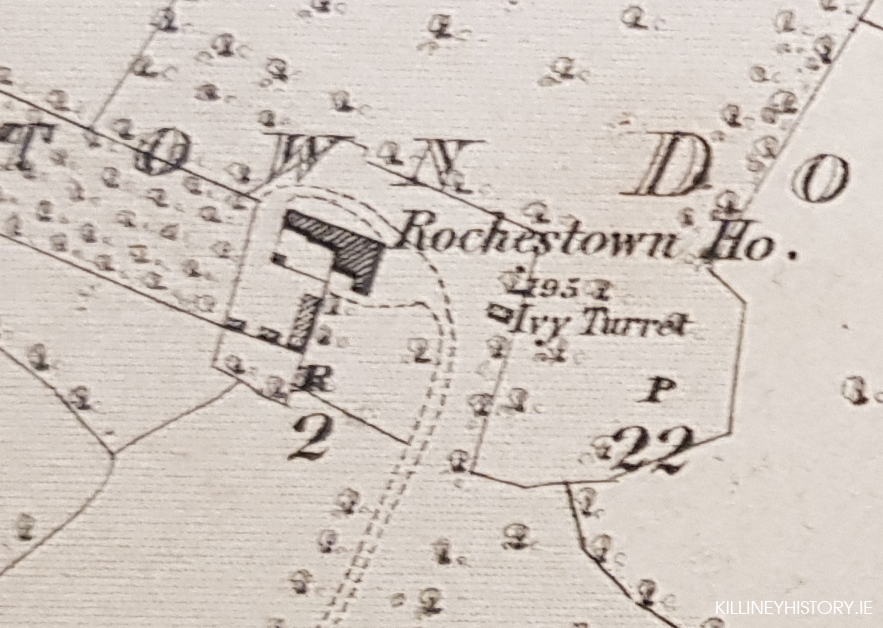
A beautiful map of the Malpas estate at Rochestown was made by Thomas Sherrard in 1787. This hand-coloured map, now in the National Library, illustrates the extent of the property, running from Kill of the Grange as far as Killiney Bay. It also gives an impression of how well planted it all was, for all the roads are lined with trees on both sides. A large formal garden and a kitchen garden are shown close to the house, and a laneway, which now provides access to the golf club, is also marked.
The order of John Malpas’s estates at Rochestown contrasts with the wilder appearance of the hills at Killiney, and this idea of the wild romantic landscape, where nature is organised by man but appears to flourish at will, must have appealed to Malpas and his eighteenth-century friends.
Today’s Rochestown Avenue already existed at the time of Rocque and, as its name suggests, was laid out as part of a grand approach to the Malpas residence.
Rochestown
Francis Elrington Ball. History of the County of Dublin (1902) pp 52-56
The fine old mansion, known as Rochestown House, was evidently in former times the residence of some family of position, and indicated until lately by its high roof and pointed gables, that it was a structure of the early part of the eighteenth century. Near it there is a great gateway and remains of a stately drive, which show that the demesne was in keeping with the house. On the lawn, in front of the mansion, there is a fragment of a castle, similar to those which stood at Seapoint and elsewhere in the neighbourhood.
The lands appear to have been originally included under those of Dalkey, and were probably the lands of that place for which the Talbot family rendered annually to the Crown, in the thirteenth century, a goshawk, or its value, 6s. 8d.,—a substantial sum in those days. On account of their use for falconry, hawks were then much prized, especially Irish ones, and the goshawk was one of the largest birds used in the sport. Sometimes the value of the bird was paid, but the owner of Rochestown, in 1369, rendered his rent in kind, and had the effrontery to deliver a useless goshawk, for which he was fined by the Court of Exchequer. The tithes were paid to the Priory of the Holy Trinity, which was no less careful than the Crown to protect its rights, and employed an agent to see that the full amount of corn was delivered into its granary at Dean’s Grange. About the middle of the sixteenth century, the lands, which were occupied by a son of the owner of Loughlinstown, James Goodman, and on which a castle then stood, were held by the Talbots of Belgard, under another branch of the family, described as of Rathdown, and, possibly, were “the castle and lordship of Yenah called Dalkey,” which, in 1563, was assigned by Robert Talbot, of Belgard, to Matthew Birsell and Thomas Lawless.
At the beginning of the seventeenth century the lands of Rochestown, to which those of Scalpwilliam were joined, and on which there were, besides the castle, a number of houses and a wood of considerable extent, had come into the possession of John Fagan, of Bullock, who held them under the Talbots. They were probably assigned by him to Alderman Robert Kennedy, who, before his death, in 1624, had purchased them in fee. Kennedy was a friend of John Fagan’s father, and owned much property in Dublin, including a celebrated mansion called Carberry House, in Skinner’s-row, in which he resided. He left a number of sons, and strictly entailed his real estate on his heirs male, but in the troublous times the family became extinct in the male line, and Rochestown was claimed, on the Restoration, by Patrick Mapas, the son of his youngest daughter.
The Mapas family was of great antiquity in the County Louth where, in the fourteenth century, one of the name had been the victor of Edward Bruce. During the eighteenth century, first as Roman Catholics, and afterwards as Protestants, the owners of Rochestown occupied a leading place in the County of Dublin. Patrick Mapas, whose father was one of the first of the family to settle in Dublin, died while the claim to Rochestown was before the court, but the proceedings were carried on by his widow, on behalf of their eldest son, Christopher, then a minor, and a decree was given in his favour. The occupant of the Castle, Matthew Boyce, was obliged to vacate it, and the Mapases came to reside there. Soon afterwards, in 1674, Christopher Mapas made an alliance with the leading Roman Catholic family of the county, the Fitzwilliams of Merrion, by his marriage to a daughter of the third viscount, a lady who is said to have been “an extraordinary wife, mother, and family woman, most pious and truly charitable.” In spite of the fact that his name and that of his brother, Lieutenant John Mapas, of Dongan’s Dragoons, appear in a list of persons attainted by William III., Mapas contrived to retain his property, and was amongst the few Roman Catholics allowed to carry arms and to keep a sword, a case of pistols, and a gun. He was a gentleman of “the most worthy and honest character, and of unknown charity,” and his death, which took place in 1719, caused great lamentations among the poor. His mother, who had married as her second husband, Mr. Edward Taylor, died a few years before her son, in 1711, leaving in her will a shilling to each poor widow in Rochestown, and in the neighbouring townlands; and his widow, the Hon. Rose Mapas, survived him until 1745, when she died at Rochestown, “in all the odour of sanctity,” at a very advanced age.
Rochestown had undergone great improvements in the time of Christopher Mapas, and a modern house had been built; but the present one was probably erected by his eldest son, John Mapas, whose name, with the family arms, and the date 1750, it bears. To it were attached numerous offices, chief amongst these being a brewery and a pigeon-house, enclosed in a courtyard, and close by there were gardens, pleasure grounds, orchards, and a bowling-green. John Mapas is said to have succeeded, on his father’s death, to an estate of considerable value, and, like his father, made a good alliance, marrying a daughter of the seventh Baron of Louth. On his death, which took place in 1756, at his town house, in St. Stephen’s Green, he was succeeded by his eldest son, Christopher. The latter, who resided abroad, died, in 1765, in Germany, and Rochestown then came into the possession of his eldest son, John Mapas, who had married, in 1757, a daughter of a successor in the title conferred on Sir Gerald Aylmer, of Monkstown. She died three years later, and the house was let to Mr. Edward Nicholson, M.P. for Old Leighlin, who was connected by marriage with the Earls of Inchiquin.
A wood had existed at Rochestown from early times, as we have seen, and though clearances had been made round the house, which a contemporary writer condemns for its want of view, some fine trees still remained. Through their estate, which afforded attractive building sites, the Mapases made the existing roads, and other houses began to be built. The first of these was Granitefield, which was occupied for many years by Sir John Macartney, M.P. for Fore, who was knighted, and subsequently made a baronet, in recognition of his efforts to promote inland navigation in Ireland. In his time Granitefield was remarkable for its myrtles and arbutus trees, and for its vineries and hothouses. At Rochestown, which had a reputation as a health resort, the Right Hon. William Burton Conyngham, the great patron of Irish antiquities and art of his day, was staying, shortly before his death, in 1796, and there a gentleman, on calling to see him, found a battalion of physicians, surgeons, and apothecaries in attendance upon him. Mr. Mapas, who soon returned to live at Rochestown House, married again—a Miss Wheatley, of Cheshire—and had by her an only surviving daughter. The latter married, in 1789, Mr. Richard Wogan Talbot, who succeeded to the peerage of Talbot of Malahide, conferred upon his mother, and upon Mr. Mapas’s death, in 1797, they became the owners of Rochestown House, which has undergone many vicissitudes during the last century.
Reference to Rochestown and the Talbot family from Dalkey, Co. Dublin by M.R.L. Kelly 1952. (added 30.05.22)
ROCHESTOWN (otherwise Castletown, Dalkey). Richd. Talbot I, of Malahide, Knt., living.1193, probably had a grant of the lands later known as Castletown, Dalkey. His s. and h. Reginald in 1216 was seized and in 1223 was re-seized of 400 or 500 a. here and, according to Burke, was succeeded by his brother Adam (probably living in 1251 and perhaps he who in 1235 paid a hawk as rent for the property). His s. and h. Richd. II (perhaps Richd. that in 1284 paid rent) is said to have died in 1288. In or before 1286 he settled Malahide upon his son Milo (d. c. 1291). Possibly he had an elder son Richd. III, to whom he may have given Feltrim (to be held of the Manor of Malahide) and the Dalkey property, which before 1307 Richid. T. held in chief, being, perhaps, Richd. that in 1284 paid rent and, likely, Richd. that in 1293 paid arrears; he died in or before 1307, when his son Richd. IV succeeded to Castletown. He was of Feltrim in 1319 and, apparently, is Richd. of Feltrim and of Castletown, Dalkey, who D. states had an unsuccessful lawsuit with Richd. (c. 1287-c. 1330), son of Milo T., for the possession of the Manor of Malahide, which almost beggared T. of Malahide. He was followed successively by his son Adam, probably Sheriff of (Co.) Dublin, and grandson Reginald, who in 1369 was fined for presenting in payment of his rent for Castletown a hawk that was in bad condition. In 1373 he was summoned to Parliament and in 1395 recovered property which his grandfather had owned in Gernonsrath, Co. Meath. He probably was alive in 1404 and was succeeded by his son John, Sheriff of (Co.) Dublin in 1428, who was living in 1439.
John T. was father of Reginald, of Feltrim, who in 1457 was appointed Clerk of the Market for Co. Dublin and who was, perhaps, father of (1) Robt.of Belgard (1491 and 1513), where, possibly, he had been set up as a defender of the Pale and (2) Reginald, of Belgard, who died probably in 1517, having, perhaps, been Mayor of Dublin in 1498. Reginald of 1457 had a son John (possibly the custodian of Old Connaught in 1460 (mentioned in B.), who was father of Robt., who in 1517 was of Belgard and in 1521 paid 26s. 8d. in lieu of a hawk as rent for his lands in Dalkey; he desired that land he had bought there should be sold and. in 1524, when Sheriff of (Co.) Dublin, leaving a younger son Peter already referred to under Bullock. John, the eldest son, having died in 1520 without male issue, Robt. was followed successively at Belgard by his second son, Reginald (d. c. 1556), Sheriff of (Co.) Dublin c. 1535, grandson Robt. (d. 1563-5), who held a cas., 3 messuages and 160 a. in Rochestown from T. of Rathdown as of his Manor of Rathdown, and great-grandson Gilbert (d. 1626), during whose lifetime Feltrim came, likely by a mortgage, into the possession of the Fagans of Dublin. (For them see under Bullock.) An Inqn. says that Gilbert T. in 1599 held Rochestown from the Queen. (For his descendants at Belgard, see Note 4).
D. states that Reginald T. died in 1517 seized of Belgard and Rochestown: since Dalkey is not mentioned, Rochestown is, presumably, the name of the Dalkey property. As Robt. T., Reginald’s successor at Belgard, in 1521 paid cash instead of a hawk for his lands in Dalkey, they must have been those previously known as Castletown. B. refers to “The Castle and Lordship of Yenah called Dalkey assigned in 1563 by Robt. Talbot of Belgard to Matt. Birsell and Thos. Lawless”. Possibly Yenah represents Fenah (a wooded place) or Inagh (a place abounding in ivy). The Castletown Wood of 1624 in Rochestown appears to indentify Castletown with Rochestown. Most of the Inqns. after 1560 find that Rochestown was held of the Manor of Rathdown; but as in the first half of the seventeenth century a variety in tenures is recorded for Shanganagh as held by the Walsh family, a difference in tenure need not mean that Castletown was not Rochestown: they and “Yenah” refer to the same place. In a rocky part of Staffs are The Roches: possibly Rochestown was named from somewhat similar features. An old map shows Thomastown Rock close to Rochestown and describes part of the latter near Somerton Lodge as being very rocky.
In 1599 Gilbert T. assigned Rochestown to John Kelly, from whom it passed in 1605 from party to party, none being a Fagan (making it doubtful whether John Fagan, of Feltrim, was owner in 1611) to Aldm. Robt. Kennedy of Dublin (d. 1624). In 1611 Rochestown and Scalpwilliam (this, which appears to be Killiney Hill, means Cleft, possibly of the Hill Top) contained a cas., 40 messuages and gardens, 300 a. arable land, 20 a. meadow, 200 a. pasture and 10 a. wood. B. says that Rochestown descended from Aldm. Kennedy to the Mapases. John Mapas, who c. 1740 erected the obelisk on Killiney Hill, had a grandson John, churchwarden in 1768 and High Sheriff of Co. Dublin in 1770, through whose daughter and heiress marrying Richd. Talbot, of Malahide, Rochestown, perhaps returned to the Talbots. T.’s daughter Frances, neice of Thos. T., founder of Port Talbot in Canada, was wife of Sir Wm. Eustace, father of Alex. Talbot Eustace-Malpas, who was of Rochestown at some period not precisely known to the writer. In 1539 there was a church here. Wm. Walshe, of Rochestown, Sheriff of (Co.) Dublin in 1538 and 1539, was, perhaps, tenant of the cas. to the Talbots; and Jas. Goodman of Rochestown in 1548 (probably of the Loughlinstown family) may have been a later tenant. The cas, was demolished possibly c. the time (given in B. as 1750) that the now ruined Rochestown Ho. was erected, brick being largely used in its construction. In 1863 Matthias O’Kelly occupied the house, near which B. says there was in 1902 a fragment of a cas. Its statement that the place had been let to a Mr. Wyvill is perhaps incorrect; Sir Marmaduke Wyvill, Bt., Postmaster General, had mining lease in 1749 of that part of Rochestown known as Mt. Mapas, where mining operations began in 1751. (See Note 8.)
Extract from ‘Some residents of Monkstown’ pertaining to Rochestown House and the Malpas family. From a return made in 1766 by the curate of Monkstown as transcribed with footnotes by F.E. Ball in 1899.
By Francis Elrington Ball from: The Journal of the Royal Society of Antiquaries of Ireland , Sep. 30, 1899, Fifth Series, Vol. 9, No. 3 (Sep. 30, 1899), p. 241
We come next to Rochestown House, temporarily occupied, I think, by Mr. Edward Nicholson, collector of excise for the city of Dublin, who is married to a granddaughter of the third Earl of Inchiquin. It is a fine mansion, the largest in the neighbourhood, and the well planted demesne is one of much beauty. We admire the stately drive, and the great gates, and listen to the pleasant music of the tinkling bells which the sheep carry round their necks. (2) It is the seat of the Malpas family, to whom nearly the whole of Rochestown belongs. This family settled at Dundalk in very early times. At the close of the sixteenth century, three brothers, sons of Walter Malpas of Dundalk, came to Dublin. One of them married a daughter of Alderman Robert Kennedy, who had purchased Rochestown from the Talbots, its original owners. Kennedy had five sons, but they died without issue, and under a decree of innocence, his great-grandson, by the marriage of his daughter to Francis Malpas, succeeded to the property. He married a daughter of the third Viscount Fitzwilliam of Merrion ; and it was his son who built the obelisk on Killiney Hill, and his great-grandson, Mr. John Malpas, who is in possession of the property at the time of our visit. (3)
2. See Wilson’s “Description of Dalkey” in Exshaw’s Magazine for 1770, p. 489; Gaskin’s “Irish Varieties,” p. 198; and Dublin Journal, Nov. 10-14, 1741, for advertisement of the demesne of Rochestown, consisting of 34 acres divided into six parks, with house in good order, and extensive stabling and offices, including brew house and grillroom, with a good hopper, malt-house, kiln, and very good pigeon house; also gardens, orchard, pleasure garden, and bowling green. The house, which still exists, bears a tablet with the Malpas arms, and underneath ” John Malpas, Esq.,1750.”
3. A member of the family-Sir John Malpas-was the victor of Edward Bruce in the battle of Faughart, near Dundalk, in the fourteenth century. The Malpas succession, so far as relates to the ownership of Rochestown, is as follows:-Francis Malpas married Mary, daughter of Alderman Kennedy. His son, Patrick, married, and died in 1662-3. His eldest son, Christopher, married, in 1674, Rose, daughter of William, 3rd Viscount Fitzwilliam, and died in 1718. His eldest son, John, who built, in 1741, the obelisk on Killiney Hill, married Frances, daughter of Matthew, 7th Baron of Louth, and died in 1756. His eldest son, Christopher, married, and died in Germany in 1765. His eldest son, John, married, 1st, in 1757, Catherine, daughter of Sir Andrew Aylmer, Bart., and 2ndly, in 1762, Martha, daughter of Thomas Wheatley of Ashton, Cheshire, and died in 1793. His only surviving child (by the second marriage) and heiress, Catherine, married, in 1789, Richard Wogan Talbot, afterwards created Lord Talbot de Malahide, and the Rochestown estate thus passed again to the Talbots. See D’Alton’s “King James’s Irish Army List,” p. 292; “History of St. Audoen’s Church,” in the Irish Builder for 1886-87 passim; Prerogative and Dublin Consistorial Wills; Dublin Grants; and Funeral Entries in Ulster’s Office.
Rochestown House as described by Peter Wilson in 1768. Extract from Gaskin’s Irish Varieties 1878. pp.57-58 (added 26.01.23)
At a distance of a little more than a mile south-west of Dalkey, stands Rochestown, the seat of John Mapas, Esq., grandson to the gentleman above-mentioned. From a slight view taken of this house in passing by, it appears to be large and well furnished with offices; but the situation rather too low and confined in prospect. The demesne, indeed, is enriched with beautiful plantations of timber trees, and even common ditches are well stocked with them. By judiciously cutting down part of the trees, he hath made some opening to the house , which , till then , must have wanted air as well as prospect. As for the surrounding parks, they are well enclosed , and in general highly improved ; and some very rocky coarse grounds have been lately cleared and encompassed with stone walls. Here I saw grazing a large number of sheep, and round the neck of each was hung a bell, the tinkling of which produced a kind of rural music not at all unpleasing . New roads have been recently opened through this gentleman’s estate, and various improvements made, whereby it hath risen considerably in value, to which its vicinity to the capital and to the sea not a little contributed .
Rochestown Avenue and House. Extract from Gaskin’s Irish Varieties 1878. pp.198-200 (added 30.05.22)
Adjacent to the point, where the Killiney road intersects the famous “ Rochestown avenue,” one of the finest roads in the kingdom, and a favourite walk in summer owing to its being over-arched with trees from one end to the other, stands a quaint old rambling mansion called Rochestown house ; the favourite residence, for many years, of the late respected and ever to be lamented Mathias J. O’Kelly, Esq ., the eminent Naturalist.*
*Mr. O’Kelly was one of the founders, and honorary Secretary for some years to the Company which formed Glasnevin Cemetery, the Pere La Chase of Dublin, and though not forty years established, yet a vast Necropolis where close on three hundred thousand sleep their last sleep. Here the immortal Curran, O’Connell, and others, who in their life time were able “listening Senates to command,” have found their final resting place. The Cemetery is really worth a visit, being tastefully laid out with plants and evergreens, and abounds in beautiful monuments. Mr. O’Kelly was a member of the Royal Irish Academy, and on the Council of the Royal Zoological Gardens Society, and a member of many other Societies in Dublin. Mr. Kelly was the author of what is written on Irish shells, in Whitelaw’s “History of Dublin.”
The house from its pointed gables, and high pitched roof presents rather an imposing specimen of what may be called the Dutch order of architecture, much in vogue in Queen Anne’s time, and that of the early Georges ; and was once the country seat of the Malpas family. In Burke’s Landed Gentry, we read in the history of the Byrnes of Cabinteely, of one Walter Byrne marrying Clare, daughter of Christopher Malpas, of Rochestown, in or about the year 1700. John, known as the Squire Mapase, who erected the obelisk on Killiney hill, to provide employment for the people on his estate, during a year of scarcity, resided there. His daughter and heiress, Catherine, was married in 1789 to Lord Talbot de Malahide, and brought with her the broad acres of the Malpas estate into the Talbot family. The Honourable Captain Richard Talbot, brother to the present Lord Talbot de Malahide, resides on this portion of the estate, at Ballinclay, Killiney, a handsome modern mansion.
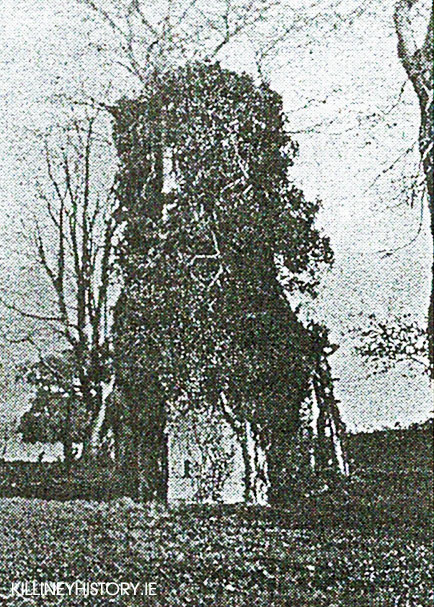
On the death of Squire Malpas, the last of his race, Rochestown house gradually went into decay, till at length it fell into the hands of an aspiring dominie who sought to convert its classic groves into an Irish Rugby. The speculation seems not to have been successful, for, after a short campaign the dominie retired, and the fine old place was again deserted. Finally, Mr. O’Kelly came the rescue; not a moment too soon, for the axe was already laid at the roots of its stately trees; which however, “Woodman had to spare,” for Mr. O’Kelly purchased all the timber as it stood. The trees in return afforded for many years their grateful shade to their kind-hearted preserver. The house is still in the possession of the O’Kelly family, and contains among many other curiosities, a large portrait of Squire Malpas, in the entrance hall; and a fine collection of Irish shells, the result of a life time spent by Mr. O’Kelly, in patient research on our coasts and inland waters. The grounds must have once been very extensive, but field after field having from time to time been added to adjoining farms, they are now sadly curtailed ; even the old entrance gateway on Rochestown avenue, and a portion of the ancient stately drive has been converted into a farm yard. In front of the house there is still standing an old ivy covered tower, which tradition points out as the place where a private marriage was celebrated at the witching time of night — while a ball was going on – between a trembling maiden of the house of Malpas and her lover true.
Rochestown House To be Let 1806
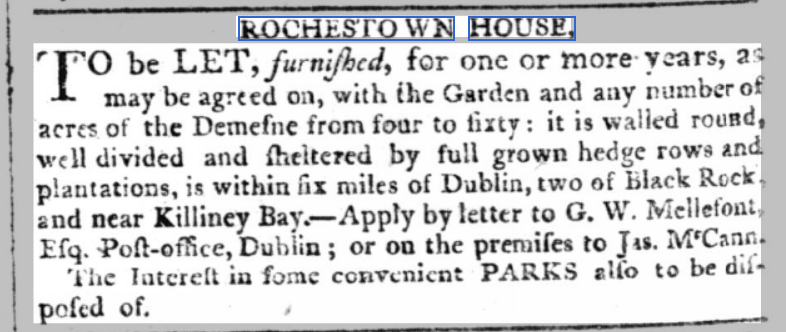
Rochestown School 1831
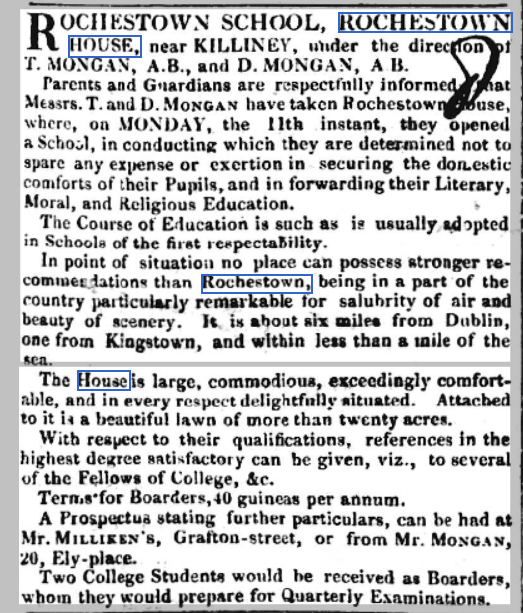
Destroyed by fire in 1923
